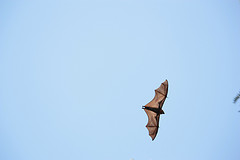As I walk my dog in the evenings this June, and the sun sets later and later, there is a fair amount of commotion in the trees and about twenty of so feet in the air above us. There are the usual birds settling down for the evening, but the fluttering I see is a flying creature without feathers. Bats often get a bad rep – they aren’t rats with wings and the ones in our neighborhood don’t drink blood (leave that to the politicians). They aren’t going to collide with you while flying at night, and they won’t (usually) pick up small dogs and children in their claws.
We should actually be encouraging our winged mammal friends to stay around. Of the forty-seven species of bats native to the United States, about eight or nine may be seen in the District of Columbia. None of our resident bats is of the vampire variety. According to the Endangered Species Handbook, a single Big Brown bat is capable of eating 600 mosquitoes in an hour. Mosquitoes on their own are a nuisance but with additional concerns about transmission of West Nile virus and other diseases the resident bats are doing the neighborhood quite a service. Other bat species, such as the Evening bat, prefer flying ants, moths, and other nighttime bugs.
Our DC bat species are fairly low key. Bats are mostly nocturnal (some are crepuscular meaning they are most active at dusk and dawn) and spend the days hanging out in trees and keeping to themselves. At night our local bats swoop and dive in search of food. I’ve experienced the dusk take-off en masse of Mexican free-tailed bats from under the Congress Avenue Bridge in Austin. It was pretty amazing to see thousands of bats take flight in silhouette against a fading sky. Some of the bats flew quite close to us overhead but not one bounced off me. I was also fortunate to see the hundreds of flying fox bats roosting in the Royal Botanic Gardens in Sydney. Flying fox bats are roughly the size of a small house cat and eat fruit. And then there was the walk-through bat exhibit at the Munich Zoo, where halfway through I realized there was no glass separating me and the flying bats and I ran out screaming like an actor in a bad horror movie.
A common misconception about bats is that they all carry rabies. The reality is that an average of two people each year in the entire United States have died from rabies that came via contact with a bat. More people are infected by rabid dogs each year than bats. There is a chance any wild animal can carry rabies, so when you are out and about on the Hill in the evenings give bats (and opossums and raccoons and anything else) some space. Don’t approach an injured bat, or one that is active in the daytime: call 311 or animal control if you think a bat needs some assistance. Otherwise, bats can be pretty fun to watch flying at dusk, and from a distance can be seen as productive members of your family.
One of the ways you can encourage bats to take up residence and help you with your summer insect issues is to construct a bat box – sort of like a birdhouse but with no ledge for a nest. Instructions for how to build a bat box and where to locate it can be found through Bat Conservation International, a nonprofit group dedicated to the study and protection of these often misunderstood creatures.

